
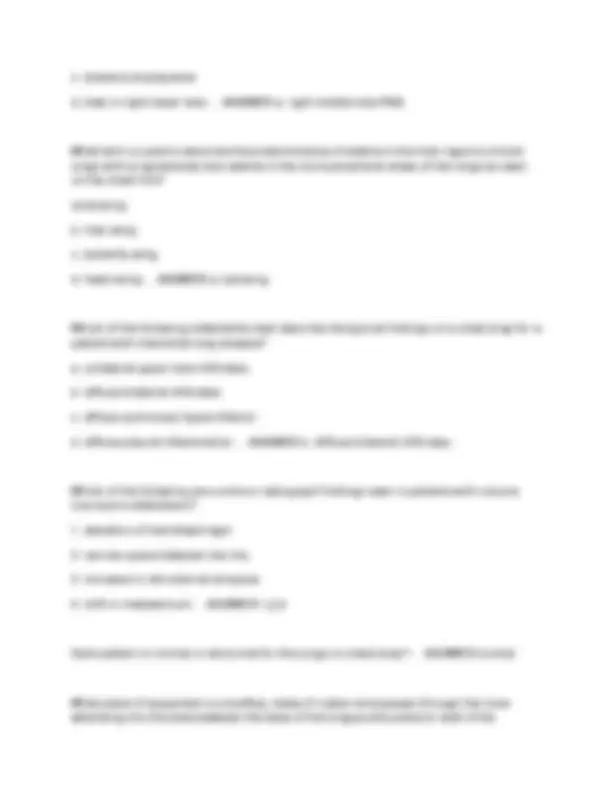
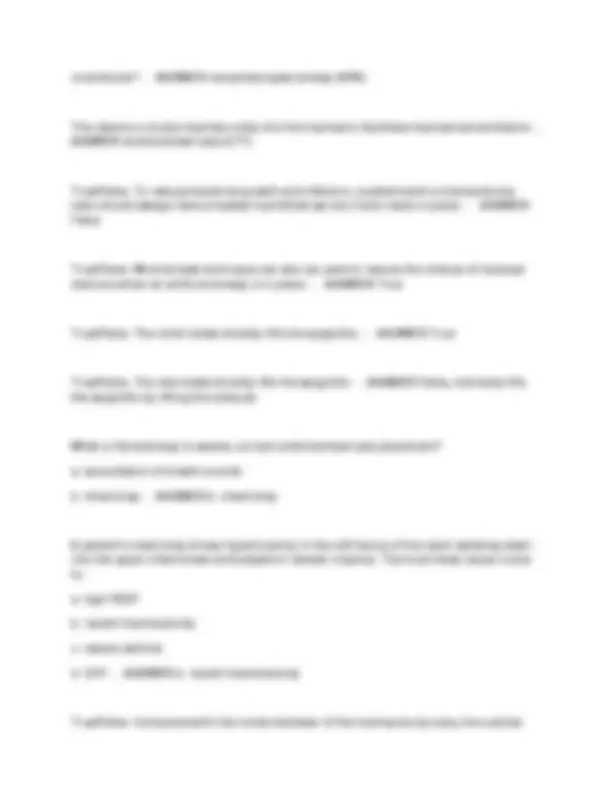
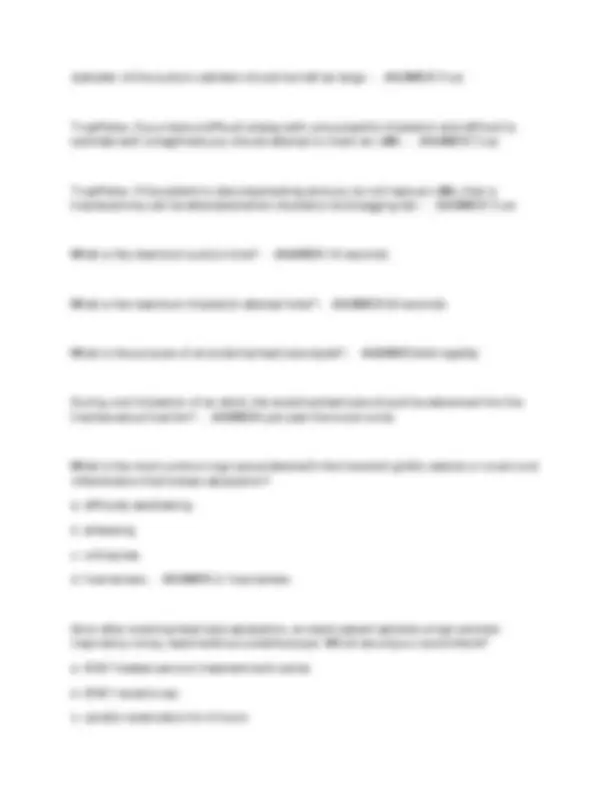
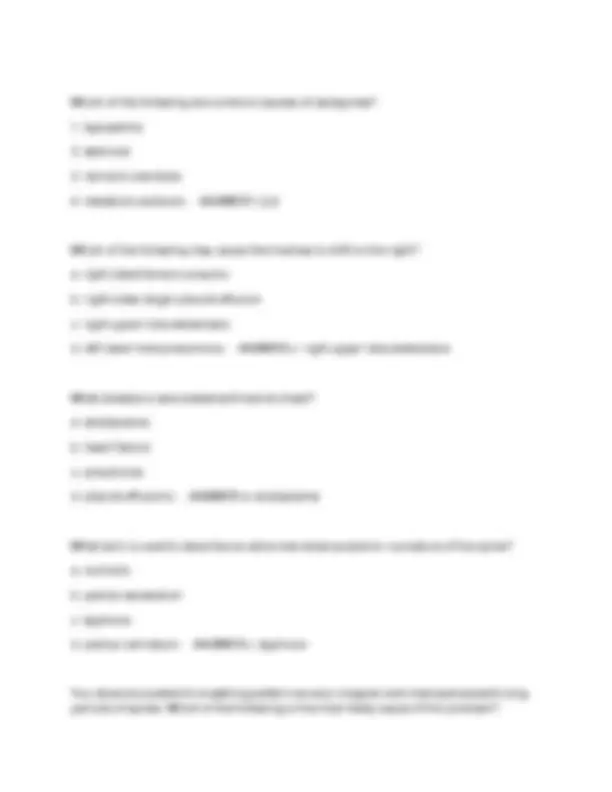
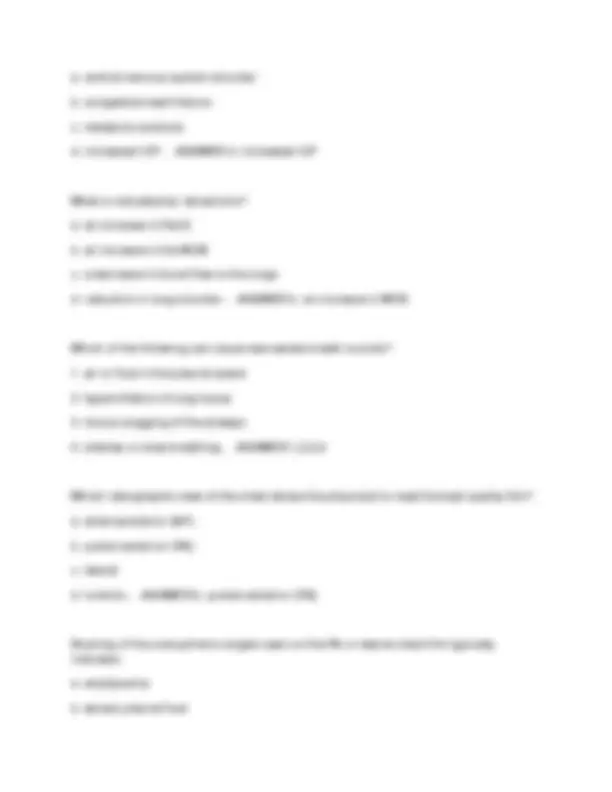
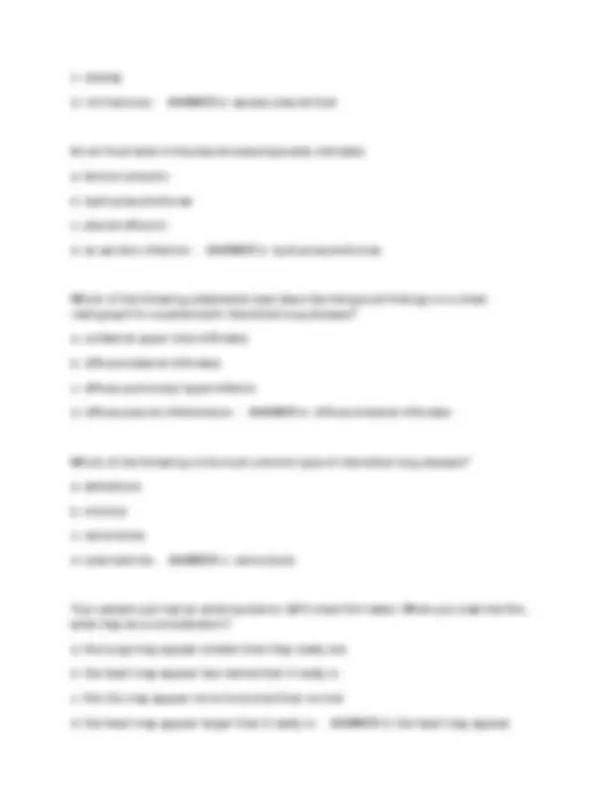
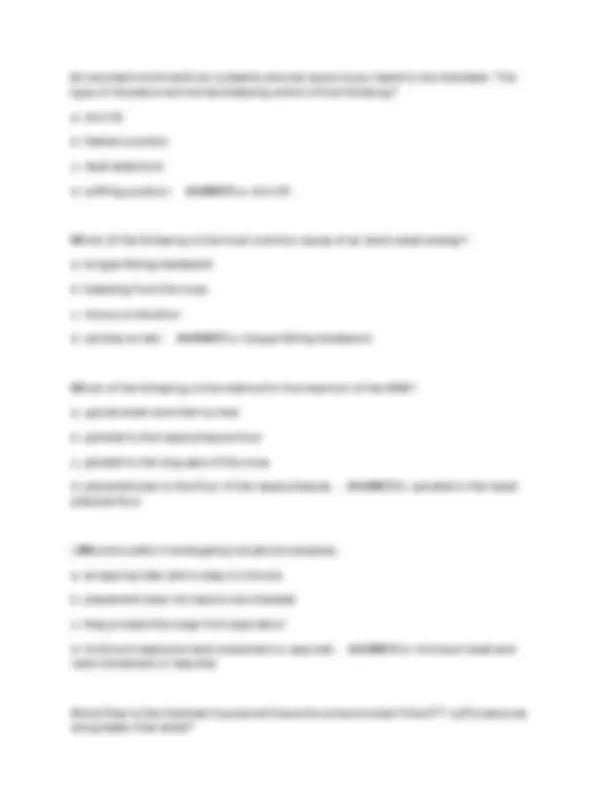
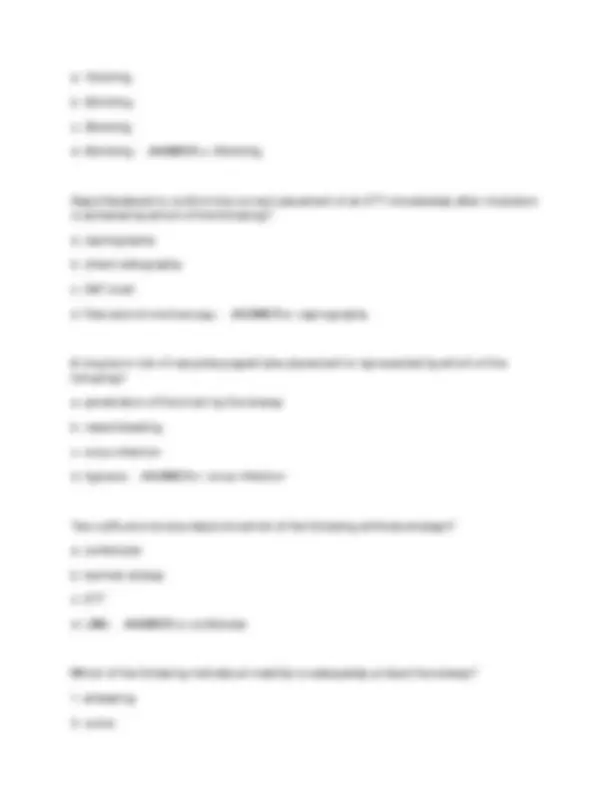
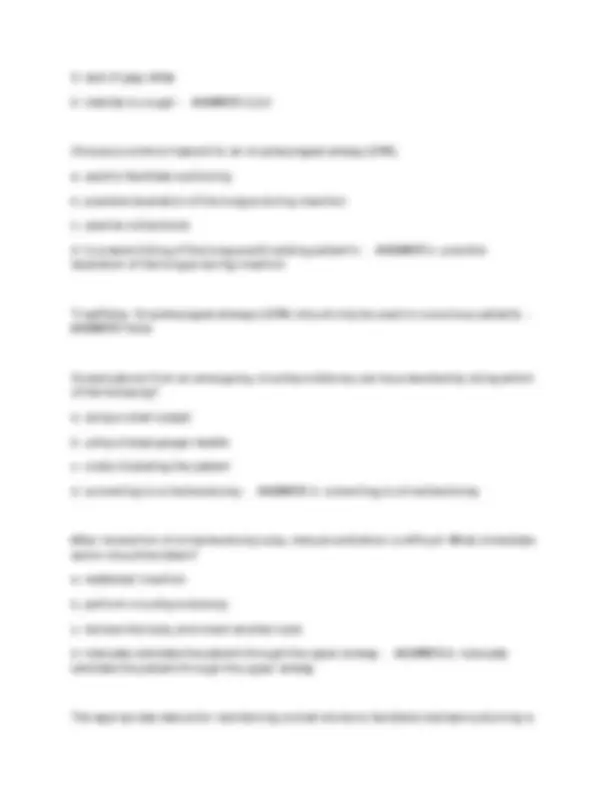
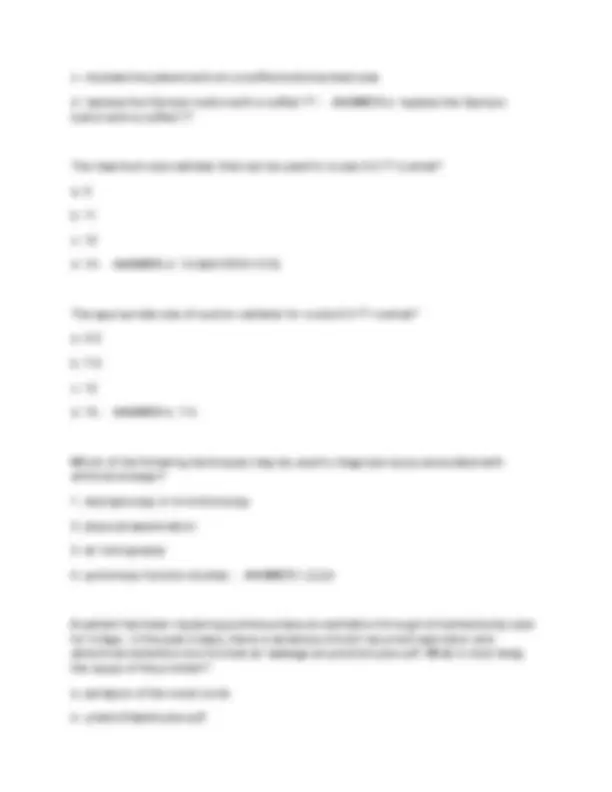
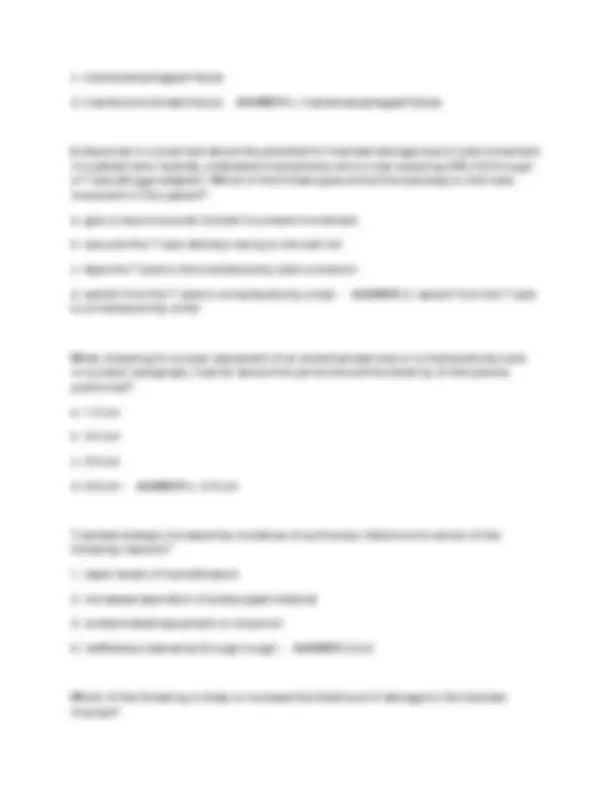
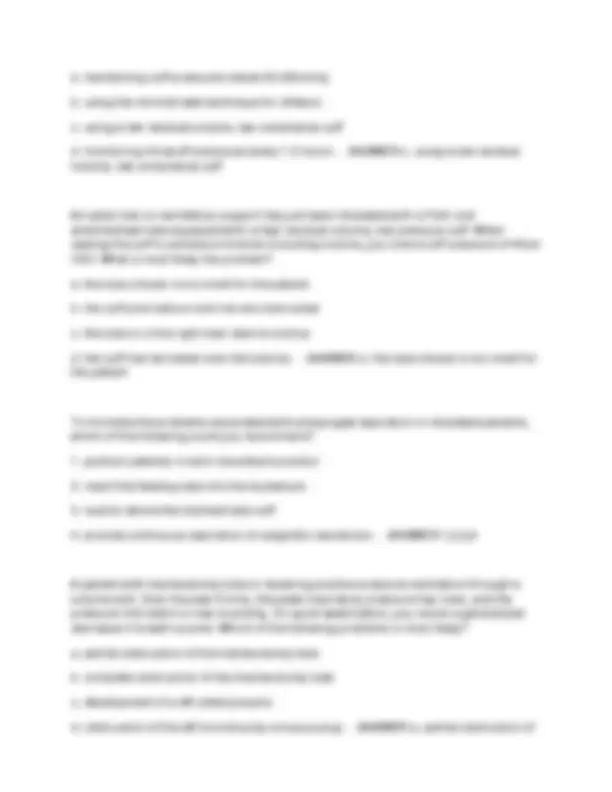
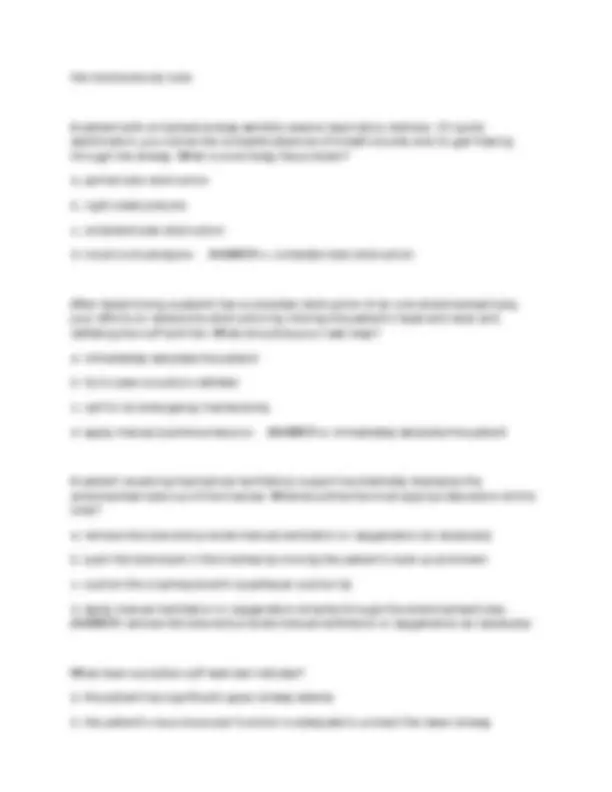
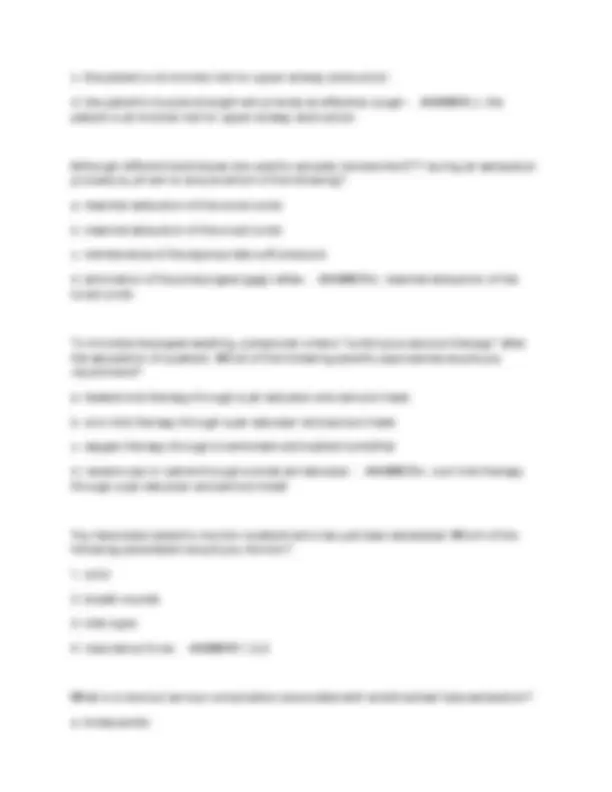
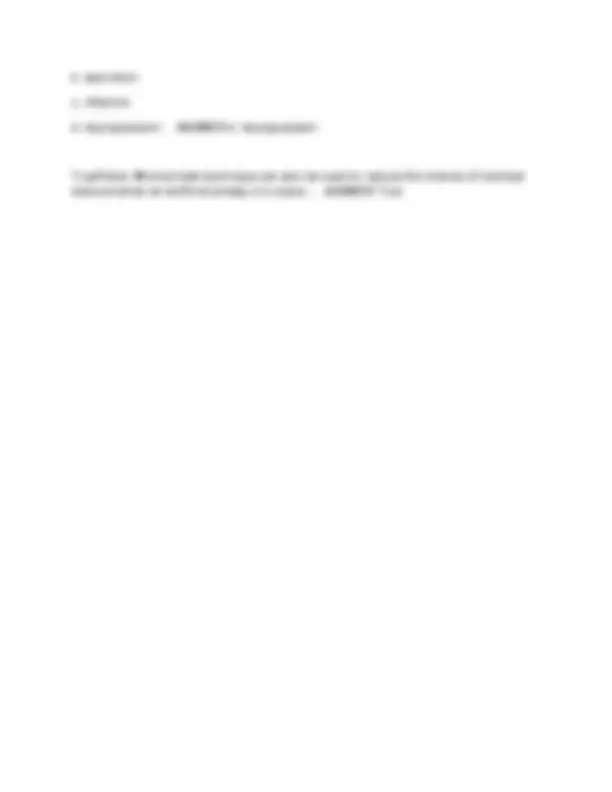


Study with the several resources on Docsity

Earn points by helping other students or get them with a premium plan


Prepare for your exams
Study with the several resources on Docsity

Earn points to download
Earn points by helping other students or get them with a premium plan
Community
Ask the community for help and clear up your study doubts
Discover the best universities in your country according to Docsity users
Free resources
Download our free guides on studying techniques, anxiety management strategies, and thesis advice from Docsity tutors
A comprehensive set of review questions and answers related to the respiratory system, covering topics such as breathing patterns, chest x-ray interpretation, airway management, and respiratory assessment. It is a valuable resource for students and professionals in the medical field who are seeking to enhance their understanding of respiratory physiology and clinical practice.
Typology: Exams
1 / 23

This page cannot be seen from the preview
Don't miss anything!
















What is a breathing pattern with increased respiratory rate called? - ANSWER Tachypnea
What is a breathing pattern with gradually increasing then decreasing rate and depth in a cycle lasting from 30 to 180 seconds, with periods of apnea lasting 60 seconds called?
What is a breathing pattern with increased respiratory rate (usually >20bpm), increased depth, irregular rhythm, and labored breath sounds called. Seen in patients with DKA? - ANSWER Kussmaul
What is the breathing pattern with increased respiratory rate and depth with irregular periods of apnea (caused by CNS) called? - ANSWER Biots
What cause tracheal deviation towards the pathology? - ANSWER pulmonary atelectasis, pneumonectomy, diaphragmatic paralysis.
What causes tracheal deviation away from the pathology? - ANSWER massive pleural effusion, tension pneumo, enlarged lymph nodes, large mediastinal mass, neck or thyroid tumors
What causes fluffy infiltrates, diffuse whiteness, bat wing appearance on CXR? - ANSWER Pulmonary edema
What causes patchy infiltrates, scattered densities on CXR? - ANSWER Atelectasis
What causes concave superior interface/ basilar infiltrates with meniscus, and blunting of the costophrenic angles on CXR? - ANSWER Pleural effusion
What change in the patient's respiratory breathing pattern is commonly seen with significant fever? - ANSWER Tachypnea
Which of the following are common causes of tachypnea?
You observe a patient's breathing pattern is very irregular and interspersed with long periods of apnea. Which of the following is the cause? a. CNS disorder b. CHF c. metabolic acidosis d. increased intercranial pressure (ICP) - ANSWER d. increased ICP
What breathing pattern is associated with severe atelectasis? a. rapid and deep b. rapid and shallow c. slow and shallow d. slow and deep - ANSWER b. rapid and shallow
The right heart shadow is not visible on your patient's chest radiograph. Which of the following pathologies may explain this? a. right middle lobe PNA b. right lung pneumothorax
oropharynx? - ANSWER nasopharyngeal airway (NPA)
This device is a tube inserted orally into the trachea to facilitate mechanical ventilation. - ANSWER endotracheal tube (ETT)
True/False. To reduce bacterial growth and infection, a patient with a tracheostomy tube should always have a heated humidified aerosol trach mask in place. - ANSWER False
True/False. Minimal leak technique can also be used to reduce the chance of tracheal stenosis when an artificial airway is in place. - ANSWER True
True/False. The miller blade directly lifts the epiglottis. - ANSWER True
True/False. The mac blade directly lifts the epiglottis - ANSWER False, indirectly lifts the epiglottis by lifting the valecula
What is the best way to assess correct endotracheal tube placement? a. auscultation of breath sounds b. chest xray - ANSWER b. chest xray
A patient's chest xray shows hyperlucency in the soft tissue of the neck radiating down into the upper chest areas and palpation reveals crepitus. The most likely cause is due to: a. high PEEP b. recent tracheostomy c. severe asthma d. CHF - ANSWER b. recent tracheostomy
True/False. Compared with the inside diameter of the tracheostomy tube, the outside
diameter of the suction catheter should be half as large. - ANSWER True
True/False. If you have a difficult airway with unsuccessful intubation and difficult to ventilate with a bag/mask you should attempt to insert an LMA. - ANSWER True
True/False. If the patient is decompensating and you do not have an LMA, then a tracheostomy can be attempted when intubation and bagging fail. - ANSWER True
What is the maximum suction time? - ANSWER 15 seconds
What is the maximum intubation attempt time? - ANSWER 30 seconds
What is the purpose of an endotracheal tube stylet? - ANSWER Add regidity
During oral intubation of an adult, the endotracheal tube should be advanced into the trachea about how far? - ANSWER just past the vocal cords
What is the most common sign associated with the transient glottic edema or vocal cord inflammation that follows extubation? a. difficulty swallowing b. wheezing c. orthopnea d. hoarseness - ANSWER d. hoarseness
Soon after endotracheal tube extubation, an adult patient exhibits a high-pitched inspiratory noise, heard without a stethoscope. Which would you recommend? a. STAT heated aerosol treatment with saline b. STAT racemic epi c. careful observation for 6 hours
What technique must be maintained when touching connection points on sterile Lukens trap? - ANSWER sterile technique
What is the technical term for secretions from the tracheobronchial tree that have not been contaminated by the mouth? a. sputum b. phlegm c. mucus d. pus - ANSWER b. phlegm
What term is used to describe sputum that has pus in it? a. fetid b. mucoid c. purulent d. tenacious - ANSWER c. purulent
Which of the following terms is used to describe coughing up blood streaked sputum? a. hematemesis b. hemoptysis c. hemolysis d. hemostasis - ANSWER c. hemoptysis
Which of the following is most commonly associated with tripodding? a. severe pulmonary hyperinflation b. congestive heart disease c. pneumonia d. pulmonary fibrosis - ANSWER a. severe pulmonary hyperinflation
Which of the following are common causes of tachypnea?
Which of the following may cause the trachea to shift to the right? a. right sided tension pneumo b. right sides larger pleural effusion c. right upper lobe atelectasis d. left lower lobe pneumonia - ANSWER c. right upper lobe atelectasis
What disease is associated with barrel chest? a. emphysema b. heart failure c. pneumonia d. pleural effusions - ANSWER a. emphysema
What term is used to describe an abnormal anteroposterior curvature of the spine? a. scoliosis b. pectus excavatum c. kyphosis d. pectus carinatum - ANSWER c. kyphosis
You observe a patient's breathing pattern as very irregular and interspersed with long periods of apnea. Which of the following is the most likely cause of this problem?
c. obesity d. rib fractures - ANSWER b. excess pleural fluid
An air-fluid level in the pleural space typically indicates: a. tension pneumo b. hydropneumothorax c. pleural effusion d. an aerobic infection - ANSWER b. hydropneumothorax
Which of the following statements best describe the typical findings on a chest radiograph for a patient with interstitial lung disease? a. unilateral upper lobe infiltrates b. diffuse bilateral infiltrates c. diffuse pulmonary hyperinflation d. diffuse pleural inflammation - ANSWER b. diffuse bilateral infiltrates
Which of the following is the most common type of interstitial lung disease? a. asbestosis b. silicosis c. sarcoidosis d. scleroderma - ANSWER c. sarcoidosis
Your patient just had an anteroposterior (AP) chest film taken. When you view the film, what may be a consideration? a. the lungs may appear smaller than they really are. b. the heart may appear less dense then it really is c. the ribs may appear more horizontal than normal d. the heart may appear larger than it really is - ANSWER d. the heart may appear
larger than it really is
Which of the following statements is false regarding the recognition and treatment of a tension pneumo as seen on the chest radiograph? a. the hemidiaphragm on the affected side will be pushed downward b. the mediastinum will be pushed toward the unaffected side c. it requires immediate insertion of a chest tube d. the patient should be intubated - ANSWER d. the patient should be intubated
Choose which scenario would best indicate the need for an artificial airway. a. a patient has an upper airway obstruction b. patient is wheezing c. patient has mild hypoxemia d. patient is hypercapnic - ANSWER a. patient has an upper airway obstruction
The following definition best describes which of the following devices: A tube inserted orally into the trachea to facilitate mechanical ventilation a. oropharyngeal airway b. endotracheal tube c. nasopharyngeal airway d. tracheostomy tube - ANSWER b. endotracheal tube
A patient is being ventilated with a bag valve resuscitation device. Their chest is not rising well with each squeeze of the bag. Your first immediate action would be to: a. intubate the patient b. suction the patient c. switch to mouth to valve ventilation d. adjust the head position - ANSWER d. adjust the head position
An accident victim with an unstable cervical spine injury needs to be intubated. This type of intubation will be facilitated by which of the following? a. chin lift b. fowlers position c. neck extension d. sniffing position - ANSWER a. chin lift
Which of the following is the most common cause of an obstructed airway? a. tongue falling backward b. bleeding from the nose c. mucus production d. cardiac arrest - ANSWER a. tongue falling backward
Which of the following is the method for the insertion of the NPA? a. upside down and then turned b. parallel to the nasal pharynx floor c. parallel to the long axis of the nose d. perpendicular to the floor of the nasal pharynx - ANSWER b. parallel to the nasal pharynx floor
LMAs are useful in emergency situations because: a. an appropriate size is easy to choose b. placement does not have to be checked c. they protect the lungs from aspiration d. minimum head and neck movement is required - ANSWER d. minimum head and neck movement is required
Blood flow to the tracheal mucosa will become compromised if the ETT cuff pressures are greater than what?
a. 15mmHg b. 20mmHg c. 25mmHg d. 30mmHg - ANSWER c. 25mmHg
Rapid feedback to confirm the correct placement of an ETT immediately after intubation is achieved by which of the following? a. capnography b. chest radiography c. CAT scan d. fiberoptic bronchoscopy - ANSWER a. capnography
A long term risk of nasopharyngeal tube placement is represented by which of the following? a. penetration of the brain by the airway b. nasal bleeding c. sinus infection d. hypoxia - ANSWER c. sinus infection
Two cuffs are incorporated into which of the following artificial airways? a. combitube b. berman airway c. ETT d. LMA - ANSWER a. combitube
Which of the following indicate an inability to adequately protect the airway?
which of the following? a. tracheal button b. luer-lok system c. transtracheal needle d. silastic TT - ANSWER a. tracheal button
The function of a double-lumen endotracheal tube is to: a. facilitate speaking b. protect one lung from the other c. maintain a tracheostomy stoma d. assist in weaning a patient from a TT - ANSWER b. protect one lung from the other
The size a suction catheter should be: a. a 12 french catheter b. the same as the internal diameter of the ETT c. two thirds the size of the outer diameter of the ETT d. less than half of the ID of the artificial airway - ANSWER d. less than half of the ID of the artificial airway
Endotracheal tube suctioning should be preceded by: a. pulse oximetry b. instillation of 15mL of sterile saline solution c. preoxygenation for 30 seconds d. hyperinflation for 60 seconds - ANSWER c. preoxygenation for 30 seconds
A reservoir on a manual resuscitator does which of the following? a. accumulate exhaled tidal volume with high oxygen concentration
b. allow for higher oxygen concentrations to be delivered c. increase the amount of volume being delivered d. collect exhaled volume for measurement - ANSWER b. allow for higher oxygen concentrations to be delivered
Laryngeal mask airway (LMA) placement includes the use of which of the following? a. stylet b. finger c. lighted stylet d. miller laryngoscope - ANSWER b. finger
The proper placement for transtracheal needle insertion is: a. into the cricoid cartilage b. through the cricothyroid membrane c. between the first and seconds tracheal cartilage rings d. under the hyoid bone, through the thyrohyoid ligament - ANSWER b. through the cricothyroid membrane
Complications of a cricothyroidotomy include which of the following? a. tracheal stenosis b. laryngeal stenosis c. ruptured epiglottis d. vocal cord paralysis - ANSWER b. laryngeal stenosis
A patient with an Olympic button arrives at the ER via ambulance and has a respiratory arrest in the hospital. To establish a secure airway that could be attached to a mechanical ventilator, the respiratory therapist should: a. insert a LMA b. place a NPA in the nose
c. tracheoesophageal fistula d. tracheoinnominate fistula - ANSWER c. tracheoesophageal fistula
A physician is concerned about the potential for tracheal damage due to tube movement in a patient who recently underwent tracheotomy and is now receiving 40% O2 through a T tube (Briggs adapter). Which of the following would be the best way to limit tube movement in this patient? a. give a neuromuscular blocker to prevent movement b. secured the T tube delivery tubing to the bed rail c. tape the T tube to the tracheostomy tube connector d. switch from the T tube to a tracheostomy collar - ANSWER d. switch from the T tube to a tracheostomy collar
When checking for proper placement of an endotracheal tube or a tracheostomy tube on a chest radiograph, how far above the carina should the distal tip of the tube be positioned? a. 1-2 cm b. 2-4 cm c. 3-6 cm d. 6-8 cm - ANSWER c. 3-6 cm
Tracheal airways increase the incidence of pulmonary infections for which of the following reasons?
Which of the following is likely to increase the likelihood of damage to the tracheal mucosa?
a. maintaining cuff pressures below 20-25mmHg b. using the minimal leak technique for inflation c. using a low residual volume, low compliance cuff d. monitoring intracuff pressures every 1-2 hours - ANSWER c. using a low residual volume, low compliance cuff
An adult man on ventilatory support has just been intubated with a 7mm oral endotracheal tube equipped with a high residual volume, low pressure cuff. When sealing the cuff to achieve a minimal occluding volume, you note a cuff pressure of 45cm H2O. What is most likely the problem? a. the tube chosen is too small for the patient b. the cuff pilot balloon and line are obstructed c. the tube is in the right main stem bronchus d. the cuff has herniated over the tube tip - ANSWER a. the tube chosen is too small for the patient
To minimize the problems associated with pharyngeal aspiration in intubated patients, which of the following could you recommend?
A patient with tracheostomy tube is receiving positive pressure ventilation through a volume vent. Over the past 5 mins, the peak inspiratory pressure has risen, and the pressure limit alarm is now sounding. On quick examination, you notice a generalized decrease in breath sounds. Which of the following problems is most likely? a. partial obstruction of the tracheostomy tube b. complete obstruction of the tracheostomy tube c. development of a left sided pneumo d. obstruction of the left bronchus by a mucus plug - ANSWER a. partial obstruction of